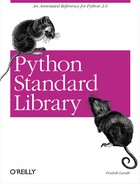“Now, imagine that your friend kept complaining that she didn’t want to visit you since she found it too hard to climb up the drain pipe, and you kept telling her to use the friggin’ stairs like everyone else...”
This chapter describes a number of modules that are used in many Python programs. It’s perfectly possible to write large Python programs without using them, but they can help you save a lot of time and effort.
The fileinput module makes it
easy to write different kinds of text filters. This module provides a
wrapper class, which lets you use a simple for-in
statement to loop over the contents of one or more text files.
The StringIO
module (and the cStringIO variant)
implements an in-memory file object. You can use
StringIO objects in many places where Python
expects an ordinary file object.
UserDict,
UserList,
and UserString are thin
wrappers on top of the corresponding built-in types. Unlike the
built-in types, these wrappers can be subclassed. This can come in
handy if you need a class that works almost like a built-in type, but
has one or more extra methods.
The random
module provides a number of different random number generators. The
whrandom
module is similar, but it also allows you to create multiple
generator objects.
